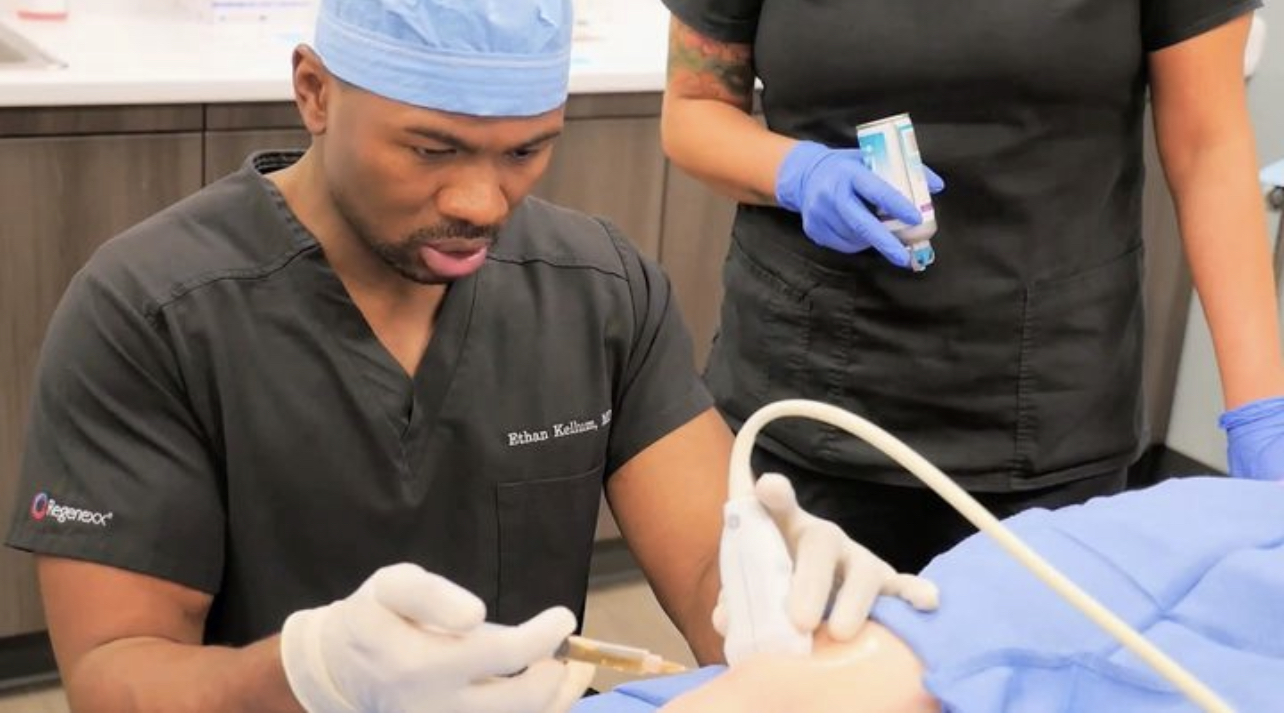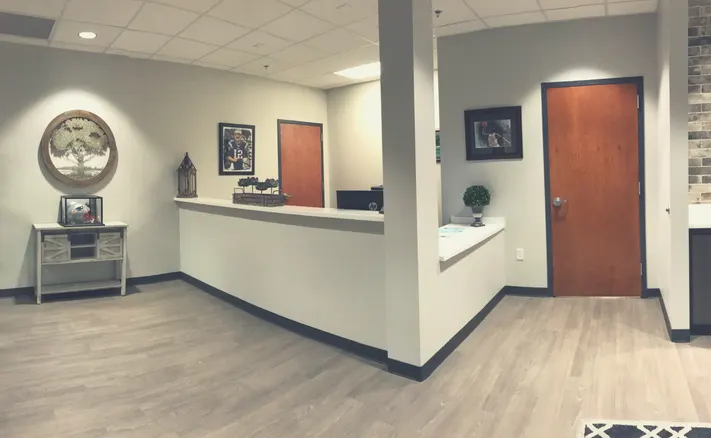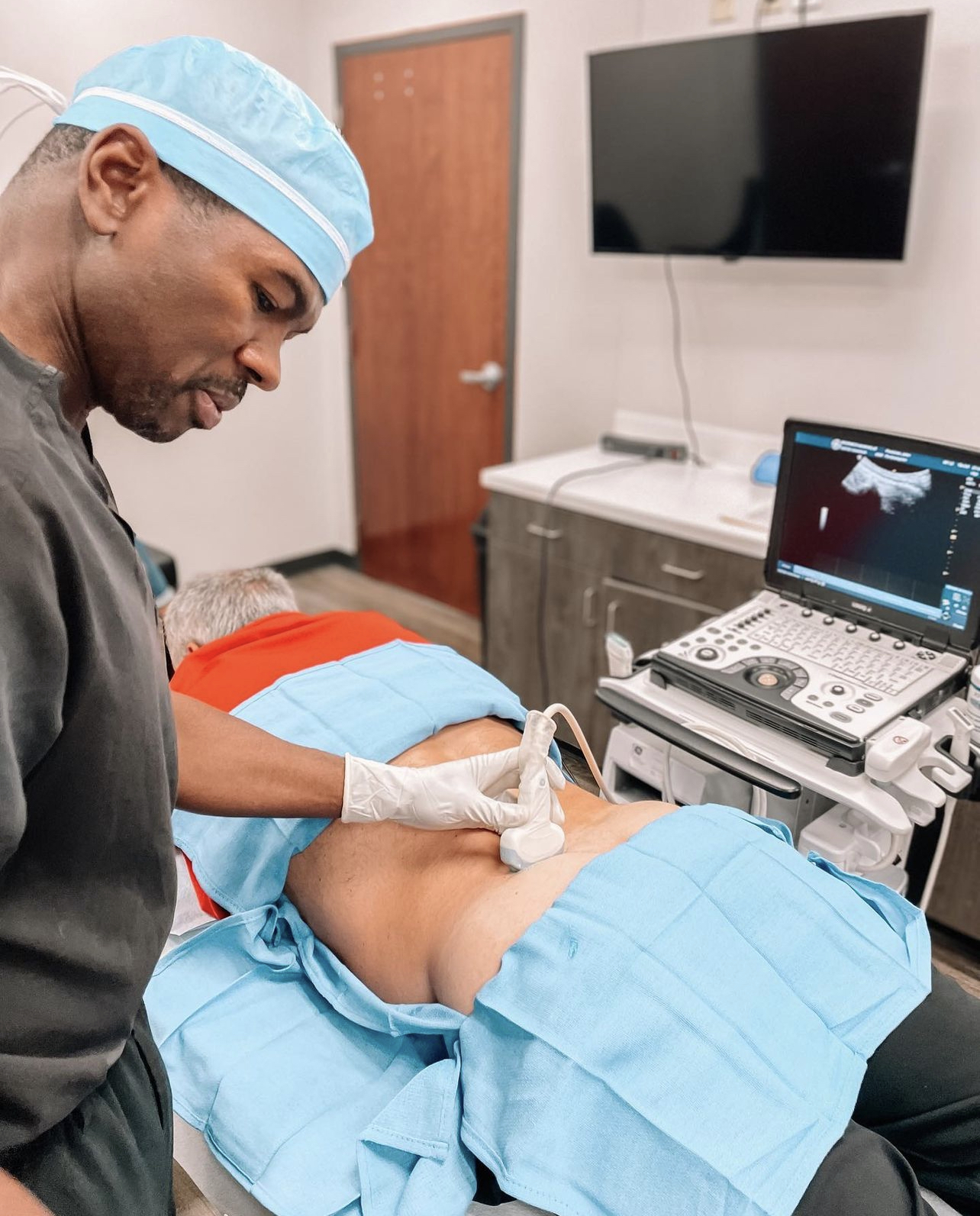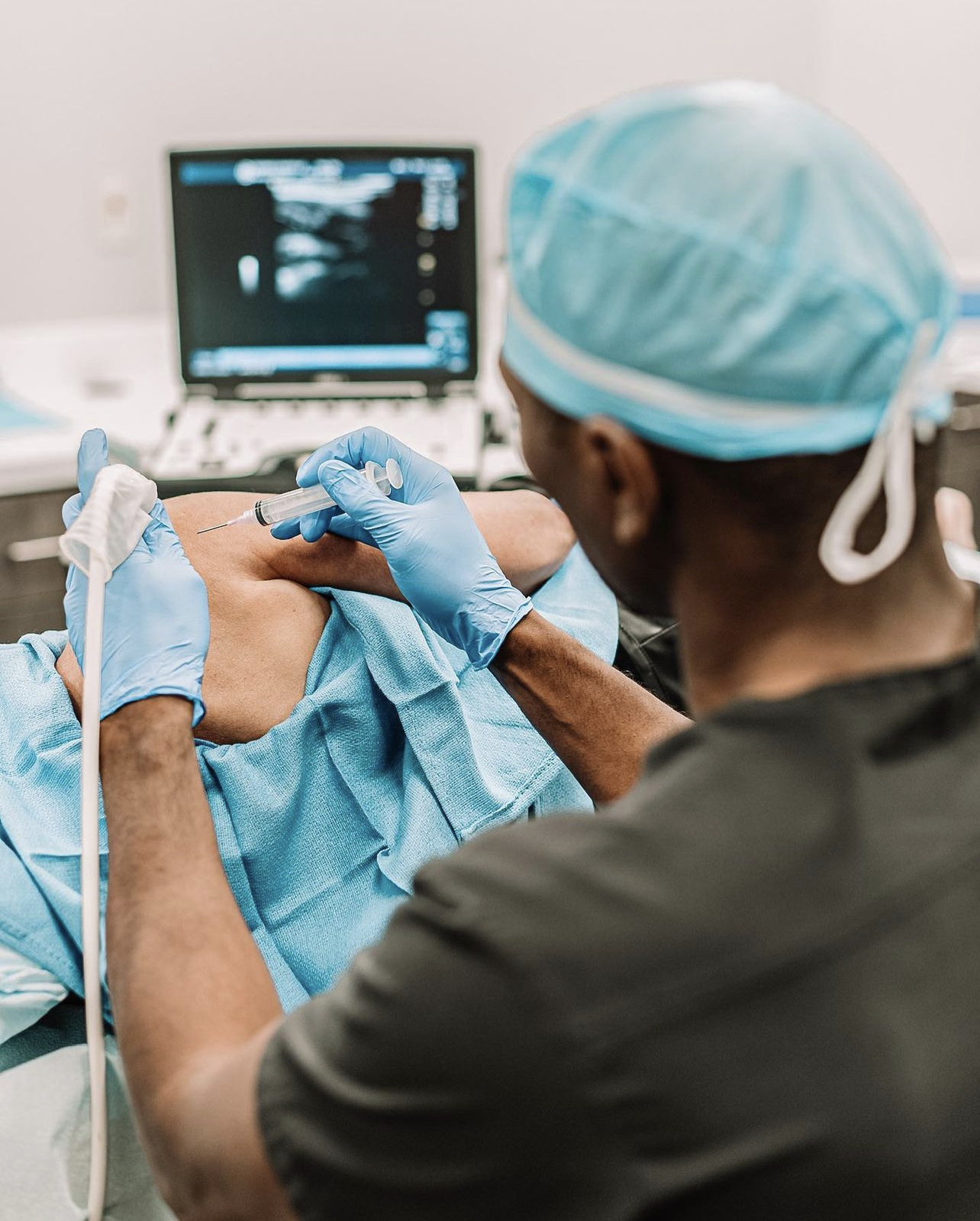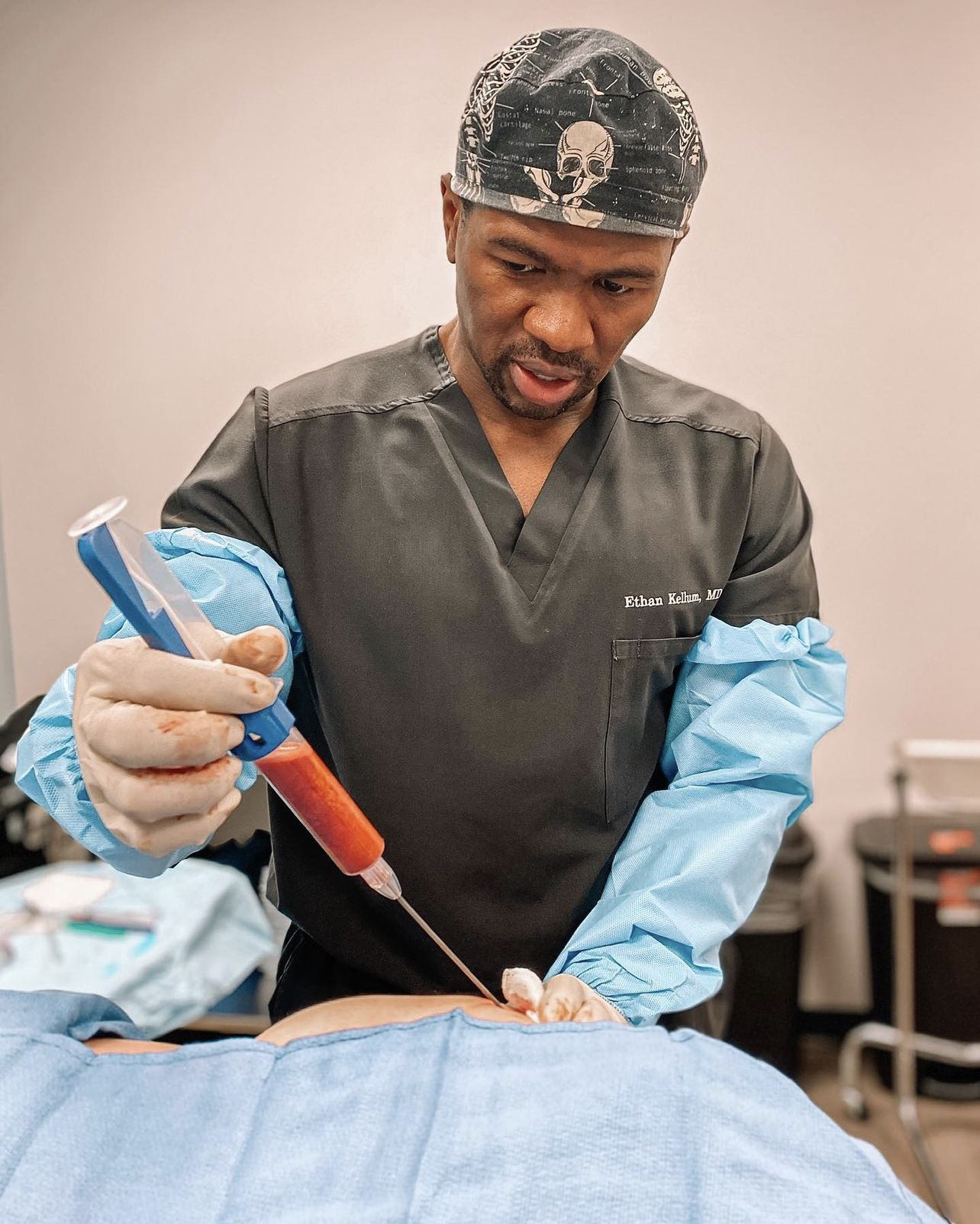Stem Cell Therapy for Lyme Disease Latest Potential Safe & Long-Term Effective Treatment for Lyme Disease
What Causes Lyme Disease?
Lyme disease is a tick-borne infection caused by a group of bacteria called Borrelia. It is the most reported vector-borne disease in the United States, with cases mainly in the northeast and upper midwest.
The disease can transmit between humans and animals through the bite of an infected black-legged tick. If left untreated, Lyme may lead to debilitating symptoms.
Lyme disease typically manifests in three stages
Stage 1: Early localized Lyme: 1 - 2 weeks following a tick bite
The most common symptom of early localized Lyme is “erythema migrans”, a characteristic bullseye rash that expands slowly with a central clearing around the initial bite. The rash is not usually painful, but it may be itchy. This bullseye rash is often the only symptom. However, flu-like symptoms, such as fever, headache, fatigue, and joint pain, are also common.
Stage 2: Early disseminated Lyme: 3 - 10 weeks following the initial bite
The most common symptoms during this stage of infection include migrating joint pains, which can involve different joints at different times.
Neurological symptoms are also typical of this stage, and can include:
- Paralysis in areas of the face, leading to the face drooping on one side
- Nerve pains
- Burning or tingling sensations in arms and legs
- Nerve damage
- Headaches
- Shortness of breath
Additional rashes are also not uncommon. These could be more of the bulls-eye type or uniformly red or patchy rashes throughout the body.
When left untreated, complications can arise as the bacteria can attack the heart and nervous systems. These can include:
- Inflammation of the heart (carditis), leading to heart palpitations and irregular heartbeat
- Inflammation of the fluid and membrane around the brain or spinal cord (meningitis) causing severe headaches and neck stiffness
Stage 3: Late Lyme disease
Late Lyme disease occurs months to years following the original infection. Commonly, people experience Lyme arthritis, which involves joint inflammation, pain, and destruction. This can be persistent or intermittent and affect one or many joints.
Neurological symptoms may become worse, with individuals reporting:
- Cognitive impairment, such as difficulty with memory or doing tasks
- Gait abnormalities, such as difficulty with walking
- Bladder dysfunction
- Brain inflammation
- Peripheral neuropathies, leading to numbness, tingling sensations, or pain in the limbs
- Mood disorders including depression and anxiety
None of these symptoms is unique to Lyme, so Lyme is often missed or misdiagnosed for many reasons. First, not all cases of Lyme start with the trademark bulls-eye rash. Second, Lyme disease can present with a wide array of obscure symptoms.
If you are in an area with many Lyme cases and you know you’ve been bitten by a tick, your doctor may prescribe a course of antibiotics to prevent a Lyme infection.
The later the stage of Lyme is, the harder it is to diagnose and treat.
Chronic Lyme, post-Lyme syndrome, or post-treatment Lyme disease (PTLDS) syndrome
Chronic Lyme or post-Lyme disease syndrome (PTLDS) can occur in 5-20% of patients after appropriate antibiotic treatment. Researchers have yet to identify a single factor that can predispose someone to this, but the mechanisms may include:
- Persistent infection
- Persistent immune system activation
- Damage to certain areas of the body from prior infection
- Changes in brain chemistry that can alter cognitive, pain, or mood pathways
Common symptoms of PTLDS are:
- Debilitating fatigue
- Changes in cognition (difficulties with thinking clearly, or “brain fog”)
- Pain
- Mental health disorders such as depression and anxiety
In chronic Lyme, these symptoms don’t go away even after months or years of antibiotic treatments. So, they can have a big impact on the quality of life and the ability to function at work and at home.
The Scientific Rationale Behind Stem Cell Therapy for Lyme Disease
While antibiotics are highly effective during the initial infection, they become less useful during later stages. Currently, there is no standard treatment for Lyme disease once it has progressed beyond the initial stages or for those with lingering symptoms following the completion of treatment.
Healthcare providers may not associate these long-term symptoms with Lyme disease, especially if someone does not remember being bitten by a tick. This can cause delays in both diagnosis and treatment.
Currently, there is no widespread consensus in the medical community on how to approach such cases, causing potentially long-term suffering and impacts on daily life.
This is where stem cell therapy may be uniquely helpful.
Once past the initial infection, standard-of-care antibiotic treatments become much more difficult and less effective. While researchers are still working to understand why, potential contributors may include:
- Residual damage from the infection
- Overactive immune system, leading to inflammation and more damage
- Inability of the immune system to fully get rid of the bacteria
- Bacterial resistance to antibiotics
- Changes to the brain
Lyme infection can be difficult to kill because the bacteria are very good at hiding from the immune system:
- Using saliva from the tick to coat it, which can prevent the immune system from developing antibodies to fight the bacteria
- Swimming into various areas of the body that are less accessible by immune cells
- By altering proteins on its cell wall that prevent immune detection
- By creating sticky biofilms to protect itself from the immune system and antibiotics, or lay dormant for long periods of time
The longer these bacteria linger, the more inflammation and damage Lyme creates.
Stem cell therapy refers to the administration of stem cells into the body to treat or manage a condition.
Stem cells are immature (also called “undifferentiated”) cells that can turn into a number of other cell types. They can also expand in numbers into more of the same stem cells.
These stem cells can replace damage that the body fails to repair naturally in many conditions. Because these cells can develop into many different cell types, they have various medical applications. For example, an adult stem cell can develop into a fat cell, neuron, cartilage, and many others.
Once stem cells become specific types of cells, they promote the production of more cells of the same type. When stem cells are administered to a specific area being treated, they can assist in repairing damaged tissues and promote healing.
Aside from replacing and repairing nerves and joints, these adult stem cells also support natural healing in other ways, such as:
- Reducing inflammation that keeps the disease going
- Attracting white blood cells to clear the infections
- Donating mitochondria to cells with damaged mitochondria. The mitochondria help produce energy for your cells, especially neurons. Treatments that improve mitochondria tend to help chronic diseases that affect the nervous system.
- Guiding the immune system to where Lyme bacteria hides so it can more effectively kill the bacteria.
Because stem cell therapy addresses so many aspects of Lyme, it is a promising treatment that can improve symptoms and quality of life
There are two types of stem cells: embryonic and adult stem cells. Embryonic stem cells come from embryos, whereas adult stem cells come from adult tissues.
At Nashville Regenerative, we use only adult stem cells harvested from the patient’s body to treat the patient. This minimizes the risk of tissue rejection and eliminates any need for immunosuppressive drugs, unlike in other types of transplants.
Adult stem cells exist throughout your body. Different kinds of stem cells exist in different places. Mesenchymal stem cells are adult stem cells that can become multiple cell types. So, they are commonly used in stem cell therapy because they are also easy to harvest. These cells are also attracted to areas with inflammation and injury, where they help reduce the inflammation and support the healing process.
These adult stem cells have been isolated from the following locations in the human body :
- Bone marrow
- Adipose (fat) tissue
- Outside layer of the bone
- Tendon
- Lung
- Umbilical cord
Bone marrow and fat tissues are common sites for stem cell harvesting. First, we isolate the stem cells from your other cells after harvesting and use them for stem cell therapy immediately. For patients who need more stem cell treatments, we send the cells to the lab to grow in a nutrient medium and expand them in numbers, which takes 6 - 8 weeks. This increased stem cell dose can then be injected, increasing the likelihood of beneficial results.
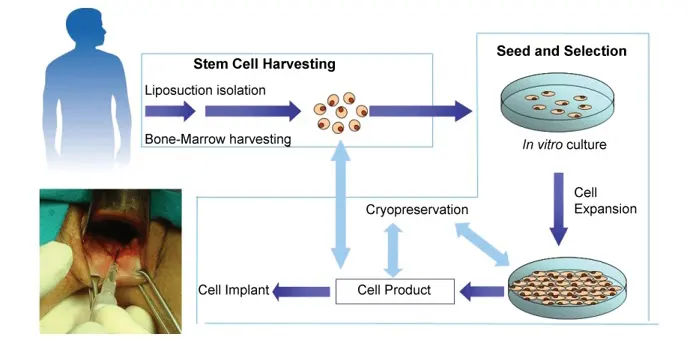
Untreated Lyme disease can cause a variety of problems, but the most common are neurological and musculoskeletal complaints.
Bacteria that cause Lyme disease like to be near joints, where they accumulate, cause inflammation, and destroy tissues. Left untreated, this damage can cause debilitating symptoms and impact the quality of life. Stem cell therapy offers a unique way to combat some of these symptoms.
The inflammation attracts the stem cells to the joint, where the stem cells promote healing and replace damaged cells. They help reduce inflammation and repair the degeneration caused by Lyme disease infection.
When Lyme bacteria spread to the nervous system, they can affect how nerves function and damage the nerves. Also, the local immune response trying to clear the infection can create inflammation that changes how the nerve sends its signals. This can lead to movement disturbances, shooting pains, muscle weakness, headaches, and changes in mood and cognition. Stem cells can deliver the following benefits for the nervous system:
- Promote nerve repair and regeneration
- Reduce inflammation and cytokine response
- Increase blood flow to the area to promote healing
The adult stem cells with multiple potentials can develop into
- Connective tissue that improves joint functions
- Immune cells that can clear debris and reduce inflammation
- Neurons that can replace lost neurological functions from untreated or post-treatment Lyme disease
Once harvested, the stem cell suspension is injected into the bloodstream and the nervous system through the spine. The stem cells can then enter the brain and seed around areas of neuron loss. They can also be injected directly into the joint capsule, where it can work to reduce inflammation, help clear cellular debris, and regenerate the joints.
For patients who need higher doses of stem cells, we culture their stem cells in the lab to expand the stem cells in number. Our US-based stem cell lab facility is FDA-registered, ISO-7 certified and certified in Good Manufacturing Practices. They will then schedule a procedure to receive the stem cell treatment once the cultures are ready.
Steps in Stem Cell Therapy for Lyme Disease
- Harvest stem cells from your bone and/or fat tissues
- Inject some stem cells right away
- Culture some stem cells in our lab to increase cell numbers
- Get the stem cells back and inject the concentrated suspension (~6 - 8 weeks later)
Stem cell therapy for Lyme disease has been emerging in recent years. While there are only a few clinical trials in patients with persistent infection, results have been promising.
Lyme could become chronic if the immune system fails to clear the infections. When Lyme bacteria spread throughout the body, the immune system also becomes less effective. Stem cells may help by:
- reducing inflammation
- supporting immune functions in regions affected by Lyme
- repairing or replacing damaged tissues
- restoring healthy tissues and organ functions
Stem cells can replace damaged neurons and brain cells, improving neurological disturbances and motor abilities in those receiving treatment 19. This was confirmed in multiple clinical trials in other diseases that affect the nervous system, including spinal cord injuries, Parkinson’s disease, and multiple sclerosis. In these studies, those receiving stem cell treatment showed major improvements in their ability to regain strength and balance.
In many other neurologic conditions, stem cell therapy has been promising and findings from such studies may translate to those with Lyme disease. Animal models have shown stem cell ability to migrate to nervous system tissues and promote regeneration via modulation of the immune response and differentiation into neural cell types.
Few clinical studies are available for stem cell therapy in Lyme, but the published studies have been promising. We’ve also observed great benefits among our patients.
Stem cell therapy may reduce inflammation, support neuronal repair, and boost brain blood flow.
Low brain blood flow is a sign of brain inflammation. In a clinical trial, 59 Lyme patients received stem cell therapy for 56 days. Brain imaging showed that the stem cells can go to the brain regions affected by the infection. Also, stem cell therapy improved brain circulation, which may indicate reduced brain inflammation and improved healing. The authors concluded that stem cells may offer a promising treatment in those with neurological symptoms due to Lyme disease.
Stem cell therapy may also help strengthen immune function in people with weakened immune systems.
In a case report, an 18-year-old young male patient with a weakened immune system received embryonic stem cell therapy. Prior to the treatment, he had a history of multiple infections, neurologic conditions, active inflammatory mold, autoimmune disease, and Lyme. At 1.5 years post-treatment, his symptoms stabilized with much less frequent infections and improved immune responses. He then needed fewer immune-supportive treatments .
Stem cell therapy can help repair damage in the nervous system and improve neurologic symptoms.
Another case report was of a 30-year-old female, initially diagnosed with multiple sclerosis but whose condition worsened with steroid treatments. She had multiple damages in her brain and spine characteristic of multiple sclerosis, and it’s possible that Lyme may have triggered her immune system to attack her brain and spine. After receiving embryonic stem cell therapy, along with antibiotics and physiotherapy for about 6 months, she reported improved limb strength, fatigue, and spasticity. She could now walk upright without support for 40 - 50 minutes. Brain scans also showed that some damage in her nervous system had been repaired.
Response to treatment is highly individual, and there are many factors that determine stem cell therapy efficacy, such as symptom duration, disease manifestations, and the efficacy of previous interventions. Those who have exhausted traditional treatment options for persistent symptoms of Lyme disease are excellent candidates for stem cell therapy.
The evidence for stem cell therapy specific to certain stages of Lyme disease has thus far been inconclusive. Lyme disease responds extremely well to antibiotic therapy if caught early, so stem cell therapy may be less suitable for acute infections. However, in untreated or chronic cases in which symptoms have persisted following antibiotic therapy, stem cell therapy can be very beneficial.
Some case studies have suggested that stem cell therapy may be beneficial in combination with antibiotic treatment. However, to date, the only available cynical evidence is only limited to case studies.
The cost depends on the specific treatment you will be undergoing and how many treatment sessions you need. Book a consultation with us today to get your personalized stem cell therapy treatment plan.
Typically, you will need 1 - 2 treatments, depending on the plan of care established between you and your doctor. All treatment appointments are in person, but the initial consultation and follow-up can be done by phone.
Some people do come back for additional treatments over the course of months or years. This largely depends on the stage of your disease, how well you respond to the treatment, and what your treatment goals are.
Your Patient Journey with Stem Cell Therapy for Lyme Disease
Step 1: Application and initial consultation
Our questionnaire and initial consultation help us determine whether you’re a good candidate for stem cell therapy, along with the best treatment plans for you. Our patient advocate will walk you through the process, pricing, and payment plans.
Step 2: Physical exam
You’ll come in for a physical exam in preparation for the treatment and also to assess your current symptoms and health status.
Step 3: Stem cell collection
Your procedure will begin where we harvest cells from your bone marrow or fat tissues. We will then isolate the stem cells from these tissues in the clinic before administering your first treatment.
Step 4: Stem cell culture
If applicable, we will send your stem cells to the lab to expand them in numbers.
Step 5: Future treatments
Your future stem cell treatments will be done using your cultured stem cells.
Step 6: Follow-up appointments
Our team will keep in contact with you to monitor your treatment progress and support you through your recovery.
Advantages of Stem Cell Therapy vs Standard Treatments and Other Alternative Treatments for Lyme Disease
Current Standard-of-Care Treatments for Lyme Disease and Their Shortfalls
Treatment guidelines for Lyme disease vary depending on initial presentation. Acute cases are typically treated with antibiotics, while persistent cases are treated by managing symptoms. For those with chronic Lyme disease symptoms, there are no established standard-of-care guidelines, leaving many patients to turn to alternative options.
Antibiotics are standard care for those seeking care shortly after a tick bite and who have a bull’s eye rash. In such cases, the treatment response is good, and many recover rapidly following 1-2 weeks of treatment. As a preventive treatment, the most prescribed agent during this stage is doxycycline 100 mg twice per day. Alternatives include amoxicillin 500 mg three times per day or cefuroxime 500 mg twice per day.
Doxycycline is the most common antibiotic used for Lyme, and it has many potential side effects.
Mild side effects of antibiotics can include:
- Headaches
- Nausea (feeling sick)
- Vomiting (throwing up)
- Skin sensitivity to sunlight, which can increase the risk for burns
- Antibiotic-associated diarrhea
More severe side effects include:
- Bruising or bleeding you can’t explain (this can include nosebleeds), sore throats, fever, and a tired feeling. These all can be signs of blood problems.
- Diarrhea with blood or mucus in it
- Ringing or buzzing in ears
- Liver problems: pale stool and urine, yellowing of the eyes, yellowing of skin
- Joint or muscle pains
- Severe headaches and problems with vision, which could be a sign of too much pressure in the brain
- Severe stomach pains
Antibiotic use, especially for a long time, can affect the gut flora and overall long-term health. It allows for Clostridium difficile infections, which can severely inflame the gut, causing severe diarrhea and potentially life-threatening sepsis. More importantly, antibiotics can cause bacteria in your body to become antibiotic-resistant, making any future infections or surgeries much riskier.
For those who have neurological symptoms of Lyme disease, such as pain in the face or limbs, or other neurological symptoms, antibiotics remain the standard of care. Treatment varies depending on the presenting neurological symptom.
- Facial nerve palsy: doxycycline 100 mg twice per day for 14-21 days
- Lyme meningitis (inflammation in the membranes that cover your brain and spinal cord) or inflammation of spinal nerves: doxycycline 100 mg twice per day for 14-21 days or ceftriaxone 2 g intravenously once per day for 14-21 days
These antibiotic treatments are aimed at killing the Lyme bacteria. Doxycycline may also help balance the inflammation. However, these medications don’t help repair the damage or address weakened immune functions caused by Lyme.
Heart symptoms can be treated with oral or IV antibiotics depending on the severity of the infection, with most patients recovering within 1-6 weeks. Typical interventions include doxycycline 100 mg twice per day for 14-21 days or ceftriaxone 2 g intravenously once per day for 14-21 days.
An initial episode of Lyme arthritis is typically treated with a four-week course of oral antibiotics, with some individuals requiring an additional course. If symptoms persist after the second round of treatment, guidelines advise there is generally no additional benefit to continued prescribing. The most prescribed agent during this stage is doxycycline 100 mg twice per day. Alternatives include amoxicillin 500 mg three times per day or cefuroxime 500 mg twice per day.
While most cases of Lyme disease resolve following standard antibiotic treatment, some individuals continue to have debilitating symptoms. The pain, fatigue, or difficulty concentrating can persist months after treatment completion.
While the literature reports about 90% of cases can be cured with antibiotics, some doctors may observe lower success rates with antibiotics alone. This could be due to major differences in the diagnostic criteria or what they consider to be chronic Lyme disease.
There are no current guidelines on the management of such cases and extended antibiotic therapy has not demonstrated benefit and may increase the risk for other complications. Some guidelines suggest screening for the presence of underlying disorders that may be treatable. Unfortunately, many individuals struggle with symptoms despite antibiotic treatment, impacting their quality of life and daily functioning. They may also suffer from side effects and long-term negative health effects of the antibiotic treatments.
Antibiotics don’t address many underlying aspects of chronic Lyme, nor does it support the repair of damaged tissues. Therefore, regenerative treatments like stem cell therapy can be uniquely beneficial for Lyme patients.
Why Nashville Integrative Therapy?
We are passionate about delivering safe and effective treatments to our patients, especially when standard-of-care treatments fall short. Over the years, we’ve seen the immense life-changing benefits of stem cell therapy first-hand and we’re passionate about making it available to you.

About Dr. Ethan Kellum, MD
Dr. Ethan Kellum is a pioneer in interventional and regenerative orthopedics. As a sports medicine specialist who is fellowship-trained in orthopedic surgery, Dr. Kellum is an expert in musculoskeletal injuries and joint conditions. Although he still performs shoulder and knee surgeries, his main focus has become regenerative medicine, especially stem cell therapy, to keep patients out of the operating room.
Dr. Kellum is a native of Henderson, Tennessee and attended Jackson Christian School and Freed-Hardeman University. He earned a medical degree from the University of Tennessee Health Science Center College of Medicine in Memphis. After a residency in orthopedic surgery at the Medical College of Georgia, he then completed a surgical fellowship in sports medicine, shoulder, and advanced arthroscopy at the renowned New England Baptist Hospital and Boston Children’s Hospital in Boston, Massachusetts. During his fellowship, he served as assistant team physician for the NBA’s Boston Celtics, and for both Harvard and Tufts University athletics. Dr. Kellum is a member of the prestigious Alpha Omega Alpha Medical Honor Society. Dr. Kellum has been actively involved in orthopedic surgery research throughout his medical career. He also has authored and co-authored several peer-reviewed orthopedic surgery articles and book chapters.
Beyond his credentials, Dr. Kellum is a compassionate, committed surgeon who has care and love for each and every patient he sees. It is Dr. Kellum’s passion to create an environment that treats and cares for the whole patient- mind, body and soul holistically. He aspires to build the full-body health and longevity of each of his patients through regenerative orthopedics, nutrition, exercise and complementary medicine. Dr. Kellum works to create an innovative and patient-centered atmosphere that feels like home.
What our patients are saying about our stem cell therapy
Got questions?
Speak to our patient advocate
Frequently Asked Questions
The FDA has not currently approved the majority of stem cell therapies in the US, despite demonstrated research of safety and efficacy. “Currently, the only stem cell treatments approved by the Food and Drug Administration (FDA) are products that treat certain cancers, and disorders of the blood and immune system.”
Stem cell therapy is currently not covered by insurance. As more research is done and the efficacy becomes clearer and it is FDA approved, this should change.
We offer payment plans for those in need. Book a consultation to see how we can serve you.
Stem cell therapies that use your own cells (autologous) to stimulate new cell and tissue growth are completely ethical. They also have a lower risk of immune system rejection.
We only use adult stem cells, which do not involve embryos or fetuses. These stem cells are harvested and cultured from your own tissue.
This varies by person. Some patients feel immediate improvement. On average, benefits may be seen in a matter of a few months and may continue to stay improved for many years15,16. Response to treatment may depend on various factors, including the severity of your symptoms and the duration of your illness.
The most common side effect is an injection site reaction. There is the possibility, even with your own cells, that there can be immune system reactions to the injected solution.
There have not been any Lyme-specific side effects documented in the literature.
It’s possible that your medication needs will change after receiving stem cell treatments, but the effect will be highly individual. We always recommend that our patients work with their doctors to monitor their symptoms and possibly adjust their medications. If you have been taking antibiotics long-term, or intermittently, you may be able to discontinue them once your symptoms improve. Due to the wide variation in treatments for Lyme disease, it is recommended you discuss any modifications in your current regime with your prescribing physician.
The only way to know for sure if you are a good candidate is to schedule a consultation and have the doctor assess your health and symptoms. After this, you will be given the options that are best for your individual scenario.
1. CDC. Transmission. Centers for Disease Control and Prevention https://www.cdc.gov/lyme/transmission/index.html (2023).
2. CDC. Signs and Symptoms of Untreated Lyme Disease. Centers for Disease Control and Prevention https://www.cdc.gov/lyme/signs_symptoms/index.html (2021).
3. Arvikar, S. L. & Steere, A. C. Diagnosis and treatment of Lyme arthritis. Infect. Dis. Clin. North Am. 29, 269–280 (2015).
4. Chronic symptoms. Lyme Disease https://www.columbia-lyme.org/chronic-symptoms (2018).
5. CDC. Treatment of Lyme disease. Centers for Disease Control and Prevention https://www.cdc.gov/lyme/treatment/index.html (2022).
6. Chronic symptoms. Lyme Disease https://www.columbia-lyme.org/chronic-symptoms (2018).
7. Anderson, C. & Brissette, C. A. The Brilliance of Borrelia: Mechanisms of Host Immune Evasion by Lyme Disease-Causing Spirochetes. Pathogens 10, (2021).
8. Salari, V., Mengoni, F., Del Gallo, F., Bertini, G. & Fabene, P. F. The Anti-Inflammatory Properties of Mesenchymal Stem Cells in Epilepsy: Possible Treatments and Future Perspectives. Int. J. Mol. Sci. 21, (2020).
9. Brandau, S. et al. Tissue-resident mesenchymal stem cells attract peripheral blood neutrophils and enhance their inflammatory activity in response to microbial challenge. J. Leukoc. Biol. 88, 1005–1015 (2010).
10. Gomzikova, M. O., James, V. & Rizvanov, A. A. Mitochondria Donation by Mesenchymal Stem Cells: Current Understanding and Mitochondria Transplantation Strategies. Front Cell Dev Biol 9, 653322 (2021).
11. Shroff, G. Transplantation of Human Embryonic Stem Cells in Patients with Multiple Sclerosis and Lyme Disease. Am. J. Case Rep. 17, 944–949 (2016).
12. Keshavarz Alikhani, H. et al. Application of Stem Cell-Derived Extracellular Vesicles as an Innovative Theranostics in Microbial Diseases. Front. Microbiol. 12, 785856 (2021).
13. Rustad, K. C. & Gurtner, G. C. Mesenchymal Stem Cells Home to Sites of Injury and Inflammation. Adv. Wound Care 1, 147–152 (2012).
14. da Silva Meirelles, L., Caplan, A. I. & Nardi, N. B. In search of the in vivo identity of mesenchymal stem cells. Stem Cells 26, 2287–2299 (2008).
15. Ramesh, G. et al. Inflammation in the pathogenesis of lyme neuroborreliosis. Am. J. Pathol. 185, 1344–1360 (2015).
16. Shroff, G. & Gupta, R. Human embryonic stem cells in the treatment of patients with spinal cord injury. Ann Neurosci 22, 208–216 (2015).
17. Shroff, G., Gupta, A. & Barthakur, J. K. Therapeutic potential of human embryonic stem cell transplantation in patients with cerebral palsy. J. Transl. Med. 12, 318 (2014).
18. Badyra, B., Sułkowski, M., Milczarek, O. & Majka, M. Mesenchymal stem cells as a multimodal treatment for nervous system diseases. Stem Cells Transl. Med. 9, 1174–1189 (2020).
19. Pabon, M. M. & Borlongan, C. V. ADVANCES IN THE CELL-BASED TREATMENT OF NEONATAL HYPOXIC-ISCHEMIC BRAIN INJURY. Future Neurol. 8, 193–203 (2013).
20. Das, G. S. L. Human Embryonic Stem Cell Therapy in Cerebral Palsy Children with Cortical Visual Impairment: A Case Series of 40 Patients. J. Cell Sci. Ther. 05, (2014).
21. Sankar, S. B. et al. Low cerebral blood flow is a non-invasive biomarker of neuroinflammation after repetitive mild traumatic brain injury. Neurobiol. Dis. 124, 544–554 (2019).
22. Shroff, G. Single-photon emission tomography imaging in patients with Lyme disease treated with human embryonic stem cells. Neuroradiol. J. 31, 157–167 (2018).
23. Horowitz, R. & Freeman, P. R. Improvement of common variable immunodeficiency using embryonic stem cell therapy in a patient with lyme disease: a clinical case report. Clin Case Rep 6, 1166–1171 (2018).
24. Goodlet, K. J. & Fairman, K. A. Adverse Events Associated With Antibiotics and Intravenous Therapies for Post-Lyme Disease Syndrome in a Commercially Insured Sample. Clin. Infect. Dis. 67, 1568–1574 (2018).
25. Bennett, M. J. Side effects of doxycycline. J. R. Army Med. Corps 138, 56–57 (1992).
26. Antibiotics. Cleveland Clinic https://my.clevelandclinic.org/health/drugs/16386-antibiotics.
27. Holzbauer, S. M., Kemperman, M. M. & Lynfield, R. Death due to community-associated Clostridium difficile in a woman receiving prolonged antibiotic therapy for suspected lyme disease. Clin. Infect. Dis. 51, 369–370 (2010).
28. Krakauer, T. & Buckley, M. Doxycycline is anti-inflammatory and inhibits staphylococcal exotoxin-induced cytokines and chemokines. Antimicrob. Agents Chemother. 47, 3630–3633 (2003).
29. Stem Cell and Exosome Products. https://www.cdc.gov/hai/outbreaks/stem-cell-products.html (2019).
Patients Worldwide have been treated at Nashville Regenerative Orthopedics
Are You a Candidate?
Our in-house science team has researched the many types of stem cells available today. Together with our clinical teams, we believe that using your own stem cells are the safest, most effective therapy choice for your body and your health.
Our research-based therapies use your own stem cells to accelerate your healing — without surgery.
Request an Introductory Patient Package
Receive an introductory patient package by email.


